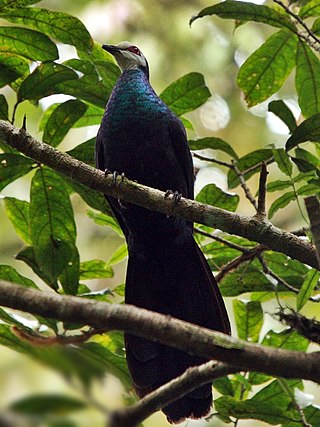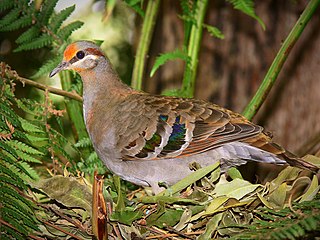
Columbidae is a bird family consisting of doves and pigeons. It is the only family in the order Columbiformes. These are stout-bodied birds with short necks and short slender bills that in some species feature fleshy ceres. They primarily feed on plants, and can be taxonomically divided amongst granivores, that feed mostly on the ground on seeds, and frugivores, that feed mostly on fruits, from branches. The family occurs worldwide, often in close proximity with humans, but the greatest variety is in the Indomalayan and Australasian realms.

The little tern is a seabird of the family Laridae. It was formerly placed into the genus Sterna, which now is restricted to the large white terns. The genus name is a diminutive of Sterna, 'tern'. The specific albifrons is from Latin albus, 'white', and frons, 'forehead'. The former North American and Red Sea S. a. saundersi subspecies are now considered to be separate species, the least tern and Saunders's tern.

Caloenas is a genus of pigeons. The only living species is the Nicobar pigeon.

Pterocles is a genus of near passerine birds in the sandgrouse family. It includes all the species in the family except for two central Asian species in Syrrhaptes.

Turacoena is a small genus of doves in the family Columbidae that are found in Indonesia.

Phaps is a genus of bronzewing pigeons in the family Columbidae that are native to Australia.

Geophaps is a small genus of doves. Established by George Robert Gray, it contains three extant species. The plumage and distribution suggests that all species within the genus have formed from a common ancestor and that through adaptive radiation they have varied greatly in size, shape and ecology.

The genus Paradisaea consists of six species of birds-of-paradise. The genus is found on the island of New Guinea as well as the nearby islands groups of the Aru Islands, D'Entrecasteaux Islands and Raja Ampat Islands. The species inhabit a range of forest types from sea level to mid-montane forests. Several species have highly restricted distributions, and all species have disjunct distributions. A 2009 study examining the mitochondrial DNA of the family found that the Paradisaea birds-of-paradise were in a clade with the genus Cicinnurus. It showed that the blue bird-of-paradise was a sister taxon to all the other species in this genus.

Wallace's fruit dove is a species of a bird in the pigeon family Columbidae. The name commemorates the British naturalist Alfred Russel Wallace. It is a rather large, long-tailed fruit dove with a length of 24–28 cm (9.4–11.0 in) and has been described as "one of the most beautiful" fruit doves. The forehead and crown are dull crimson, the lower face and throat are white, and the rest of the head, breast, neck, and upper back are pale bluish-grey. The wings and lower back are green and the belly is orange, separated from the chest by a white band. Both sexes look similar, but females have less extensive red on the head and a greenish tinge to their grey parts.

The invisible rail, Wallace's rail, or drummer rail is a large flightless rail that is endemic to the island of Halmahera in Northern Maluku, Indonesia, where it inhabits impenetrable sago swamps adjacent to forests. Its plumage is predominantly dark slate-grey, and the bare skin around its eyes, the long, thick bill, and the legs are all bright red. Its call is a low drumming sound which is accompanied by wing-beating. The difficulty of seeing this shy bird in its dense habitat means that information on its behaviour is limited.

Petrophassa, commonly known as the rock pigeons, is a small genus of doves in the family Columbidae native to Australia, and similar to bronzewing pigeons.

Chalcopsitta is a genus of parrot in the family Psittaculidae and the subfamily Loriinae. All three species are native to New Guinea and western offshore islands. The name Chalcopsitta is derived from the Greek khalkos meaning "bronze" and psitta meaning "parrot".

The blue pigeons are a genus, Alectroenas, of birds in the dove and pigeon family Columbidae. They are native to islands in the western Indian Ocean.
The spice imperial pigeon is a species of bird in the family Columbidae. It is endemic to Indonesia, where it occurs in the eastern Moluccas and the Raja Ampat Islands. Its natural habitats are subtropical or tropical moist lowland forests and subtropical or tropical mangrove forests. It eats, and is an important disperser of seeds for, fleshy fruits.

The New Guinea bronzewing is a species of bird in the pigeon and dove family Columbidae. It is found in New Guinea. Its natural habitats are subtropical or tropical moist lowland forests and subtropical or tropical moist montane forests.

The black cuckoo-dove or black dove, also known as the slaty cuckoo dove, is a species of bird in the family Columbidae. It is endemic to the Lesser Sunda Islands, being found on Timor, Wetar, Rote, and Atauro. It inhabits primary and secondary monsoon forest, eucalyptus forest, and woodlands. It is 38.5 cm (15.2 in) long on average and is mainly dark bluish-gray, lighter on the head and underparts and darker on the wings and tail. It has yellow orbital skin.

The common paradise kingfisher, also known as the Galatea paradise kingfisher and the racquet-tailed kingfisher, is a species of bird in the family Alcedinidae. It is found in subtropical or tropical moist lowland forests of the Maluku Islands and New Guinea. Like all paradise kingfishers, it has a red bill and colourful plumage. The species is common and the IUCN has assessed its conservation status as being of "least concern".

Wallace's fairywren is a species of bird in the Australasian wren family, Maluridae. It is the only species within the genus Sipodotus. It is found in New Guinea and the Aru Islands, where its natural habitat is subtropical or tropical moist lowland forests.

Columbina is a genus of small doves in the family Columbidae that live in the New World. They range from the southern United States through Central America and much of South America. Columbina doves are normally found in pairs or small flocks and generally occur in open country. They have maroon irides and pinkish legs. In flight, some species show a distinctive flash of rufous in the wings, while others show black-and-white wing-patterns.

The fruit doves, also known as fruit pigeons, are a genus (Ptilinopus) of birds in the pigeon and dove family (Columbidae). These colourful, frugivorous doves are found in forests and woodlands in Southeast Asia and Oceania. It is a large genus with over 50 species, some threatened or already extinct.




















